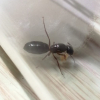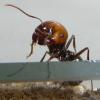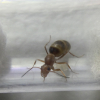4th June, 2021
I saw her pupating on the cotton, let's hope the humidity on the cotton will make her pupate successfully.

4th June, 2021
I saw her pupating on the cotton, let's hope the humidity on the cotton will make her pupate successfully.
I pray4th June, 2021
I saw her pupating on the cotton, let's hope the humidity on the cotton will make her pupate successfully.
5th June, 2021
I think they ate it but I'm still not 100% sure, it is possible that it did successfully pupate but the workers forgot to remove the substrate. If the next generation of workers still failed to pupate, I'll try experimenting different types of substrate for them.
6th June, 2021
I might have to move them to a dirt nest as one of the pupae died, do you think I should do it?
15th June, 2021
Last week, a worker sadly died. Today, a new worker has just arrived! That brings the total number of workers back up to 3!
17th June, 2021
I don't know how much longer this journal will last cause the nanitics are dying of old age!
I hope so. If not, this journal might be over forever or I can try to find another queen/colony replace this one.
19th June, 2021
I feel like a total loser now, her last worker died and the queen is all alone now. ![]()
As you may have saw in my other journal, the queen has sadly passed away.
Sorry to here Syuteo, do you think they got to wet? Looking at the last photos the substrate appeared to be full of water? It would explain why the water ran out after 4 days as well?
I guess so, next time I'll try not to do that mistake again. That's only my second colony of trap jaws successfully raised from a queen.
November 13th, 2022
I decided recontinue this journal since I found a new Odontomachus simillimus queen after my main journal temporarily discontinued. Guess I'm back to my old style of writing journals with the date in bolded text. Plus scientific names in italic because that's apparently how you're supposed to write it.
I decided to raise this queen in a different enclosure this time instead of the usual tubs and tubes setup. The setup I'm using is a small plastic container filled with cocopeat and sand, I tried using cocopeat this time because I usually find trap jaw ants nesting in cocopeat in the wild. I was hoping for her to dig in the substrate but she hsan't yet. (Don't worry, the container is not that big and it's easy to see her) For food, I cut up a mealworm and put it inside, she hasn't eaten it yet as queens that I find close to my area are usually much pickier. I'll a variety of foods to see what she likes. And to prevent invaders from killing her, the entire enclosure is put on a water moat.
November 14th, 2022
Well, nevermind. She died, I have no idea why. ![]()
![]() If I ever find another one I will update on this journal.
If I ever find another one I will update on this journal.
November 18th, 2022
I found another queen! This time I want to try something a little different, I caught the queen but I also took some workers from a different colony and put them together. Call me stupid if they eventually killed each other but, somehow they didn't and seemed to join forces. I only took two workers because due to lack of space in the container (I forgot to bring test tubes ![]() ) and that the third worker I put in is attacking the container. If they don't kill each other, then I can have a jump start of founding this colony. Also this isn't the first time it has been done, other people have tried it with other species such as Harpegnathos venator and other species of Odontomachus.
) and that the third worker I put in is attacking the container. If they don't kill each other, then I can have a jump start of founding this colony. Also this isn't the first time it has been done, other people have tried it with other species such as Harpegnathos venator and other species of Odontomachus.
Glad to see you found something this season. I have 2 colonies in experimental setups right now, and both seem to be doing fine. Colony #1 is in a tubs n tubes setup with damp soil and moss, resembling that of the forest floor, while colony #2 is in a tubs n tubes setup with dry sandy soil. I was wondering if the humidity of the nest impacts their growth rate, because it seems to have happened with colony #2.
Glad to see you found something this season. I have 2 colonies in experimental setups right now, and both seem to be doing fine. Colony #1 is in a tubs n tubes setup with damp soil and moss, resembling that of the forest floor, while colony #2 is in a tubs n tubes setup with dry sandy soil. I was wondering if the humidity of the nest impacts their growth rate, because it seems to have happened with colony #2.
I find that O. simillimus larvae are really picky of their pupating conditions, the substrate must not get too wet or too dry, and sometimes even if the substrate is at their prefered humidity they still won't pupate. This time I tried using cocopeat because I usually see them nest in cocopeat (although I found them nesting in oil palm cocopeat and I used coconut cocopeat but I can still try). I used a different setup this time similar to what Aqua Quah did in this page, you may have even been to that page before. It seems to be working and they have at least one egg.
Ant Keeping →
Ant Keeping Journals →
bmb1bee's Cryptic Colonies (updated 17 Feb. 2025)Started by bmb1bee , Dec 2 2024 |
|

|
||
Anting →
General Anting →
how many odontomachus queens fly in a nuptial flightStarted by Antz_Straya , Nov 9 2023 |
|

|
||
Ants & Myrmecology →
General →
Poll
POLL: Should I restart my odontomachus journal?Started by FinWins , Jun 17 2023 |
|

|
||
Ant Keeping →
Ant Keeping Journals →
FloridaAnt’s Odontomachus sp. JournalStarted by FloridaAnts , Jul 26 2022 |
|

|
||
Market Place →
General Market Place →
OdontomachusStarted by bugman721 , May 12 2022 |
|

|
0 members, 0 guests, 0 anonymous users